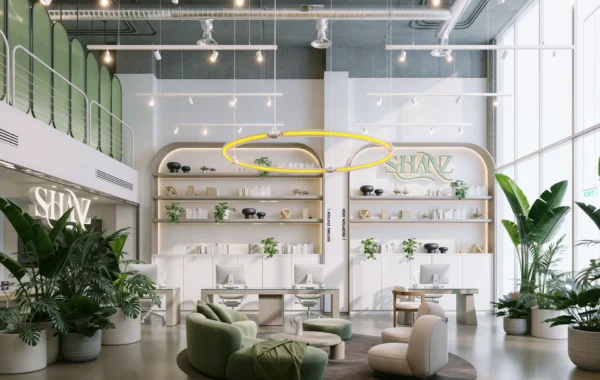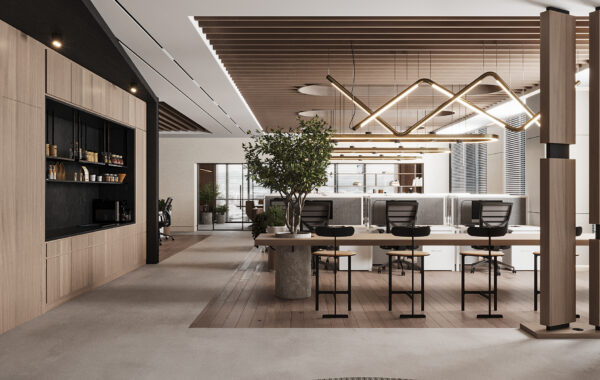
Retail Space Planning Tips for Maximizing ROI
A crucial part of the retail industry, retail space planning is a process that entails organizing and designing retail spaces to present a business’s products attractively and efficiently to appeal to a wider customer base.
The shopping experiences of consumers are highly influenced by a store’s layout, which can eventually affect the purchases that customers make. This requires retailers to focus on designing an efficient and effective store layout that not only attracts but also retains customers by physically streamlining the customer experience of a brand, which in turn helps in maximizing the return on investment (ROI) and boosting profitability.
For effective retail store space planning, we recommend getting in touch with a professional retail store interior designer and increasing your ROI through strategic retail space planning.
In the following article, we will explore practical and easy-to-implement tips for planning your retail space to ensure optimal efficiency, customer engagement, and greater revenue generation. From strategic layout designs to clever merchandising techniques, we’ll be providing expert insights and strategies that will help you make the most out of every square foot of your retail space.
What you’ll learn:
- What is a retail space?
- Why is space important in retail?
- What is retail store space planning?
- Why is retail space planning important?
- What are the benefits of space planning in retail?
- Which type of spaces are required in a retail store?
- How do you maximize space in retail?
Are you a seasoned retailer or a newcomer to the industry? Regardless of your experience, the tips below will empower you to create a highly compelling shopping environment that will not only attract customers but also drive sales and increase your bottom line.
So, let’s dive in and unlock the secrets to maximizing ROI through effective retail space planning.
What is a retail space?
A retail space refers to a physical space or outlet where businesses sell goods or services directly to their consumers. This space can vary in size and layout, ranging from small shops to large department stores.
Retail spaces are a critical component of the consumer experience, as they can significantly influence purchasing decisions and shape brand perception. These spaces are often designed and curated with great care, with a focus on showcasing products, attracting customers, and facilitating transactions.
A typical retail space includes a range of features, such as display areas, shelves, checkout counters, and fitting rooms (if it’s a clothing store). These elements are carefully tailored to meet the specific goals of the brand and its target market, with the aim of creating an optimal shopping experience that encourages customers to make purchases and build a positive relationship with the brand.
The overall atmosphere of a retail space plays a big role in the customer experience. Retailers use design elements, lighting, music, and even scent to create a specific brand image and feeling that reflects their target audience.
Your retail space could be a neighborhood boutique showcasing trendy clothing and accessories, with racks of clothing neatly displayed, and fitting rooms for customers to try on garments.
Or it could also be a bustling grocery store filled with aisles of fresh produce, shelves stocked with pantry staples, and checkout lanes for customers to pay for their groceries.
Regardless of what your retail space looks like or what it offers, one key feature of all these spaces is that they are designed to cater to the specific needs and preferences of their target customers, creating a unique and inviting shopping ambiance for their shoppers.
Why is space important in retail?
Space is one of the most valuable assets in retail that invariably impacts product sales, customer satisfaction, and brand prosperity. By prioritizing space planning and design, retailers can create engaging, profitable environments that drive business growth and differentiation in the competitive retail landscape.
Efficient use of space can maximize sales potential by optimizing product placement, traffic flow, and customer engagement. Retailers can strategically position high-margin items, create enticing product displays, and implement cross-selling opportunities to drive sales and increase revenue. Well-organized displays can attract attention, highlight key features, and encourage impulse purchases, even from afar.
Having a well-managed space also amplifies the customer experience, because it allows people to conveniently stream through your outlet, make stops at certain spots that they like, take pictures even, and generally enjoy their experience of being at your place and buying from your brand.
Similarly, by reducing traffic, expediting processes, and raising employee productivity, good space planning improves operational effectiveness. It enables retailers to minimize operating expenses, maximize inventory control, and allocate resources more wisely.
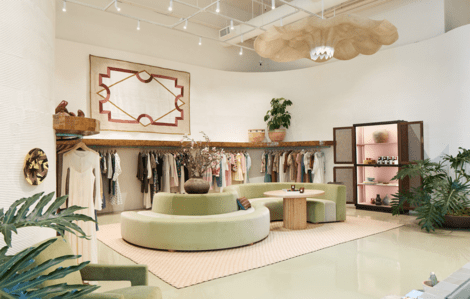
Ultimately, good space usage not only creates a positive environment for your customers to stay in and return to your store but also curates a good image of your brand. This is because the physical environment of your retail space conveys important brand messages to your customers.
The layout, decor, and ambiance reflect the identity, values, and positioning of your brand in the market. A well-planned and thoughtfully designed space can play a crucial role in reinforcing a brand’s image and enhancing customer loyalty.
What is retail store space planning?
Retail store space planning refers to the process of strategically organizing and arranging the physical layout of a retail store to optimize the use of available space and enhance the overall shopping experience for customers. This involves carefully considering factors such as traffic flow, product placement, display design, aisle width, shelving arrangement, and checkout counter positioning.
The goal of retail store space planning is to create an efficient and visually appealing layout that maximizes sales potential, improves operational efficiency, and aligns with the brand image and customer preferences.
Here are some of the key components of planning space within a retail store:
Considering Traffic Flow
In a retail environment, “traffic flow” is the term used to describe the pattern of movement that customers follow as they navigate through the store. This can include the paths they take, the areas they tend to linger in, and the points where they may encounter congestion or obstacles. Understanding traffic flow is an essential part of optimizing store layout and improving the customer experience.
To maximize exposure to products while guiding clients smoothly from one location to another, aisles and paths must be planned. Effective traffic flow prevents congestion, eliminates obstacles, and provides a smooth and pleasant shopping experience. This could include clearly demarcated sections, clear and easy-to-understand signage, and well-designed pathways to ensure easier navigation and better accessibility for your customers.
Managing Display Design
Display design commonly refers to the arrangement and presentation of a brand’s merchandise within the store. This involves selecting appropriate fixtures, props, and signage to showcase products in a way that aesthetically appeals to the customer and compels them to interact with and buy your product.
This, in turn, relates to shelving arrangement, which involves determining the placement and configuration of shelves, racks, and displays to accommodate products effectively.
By strategically showcasing key products and promotions, retailers can effectively communicate the essence of their brand and provide customers with a memorable shopping experience.
Configuring Product Placement
Product placement involves strategically positioning merchandise within the store to attract customer attention and facilitate sales. It includes decisions about where to place high-demand items, featured products, and promotional displays.
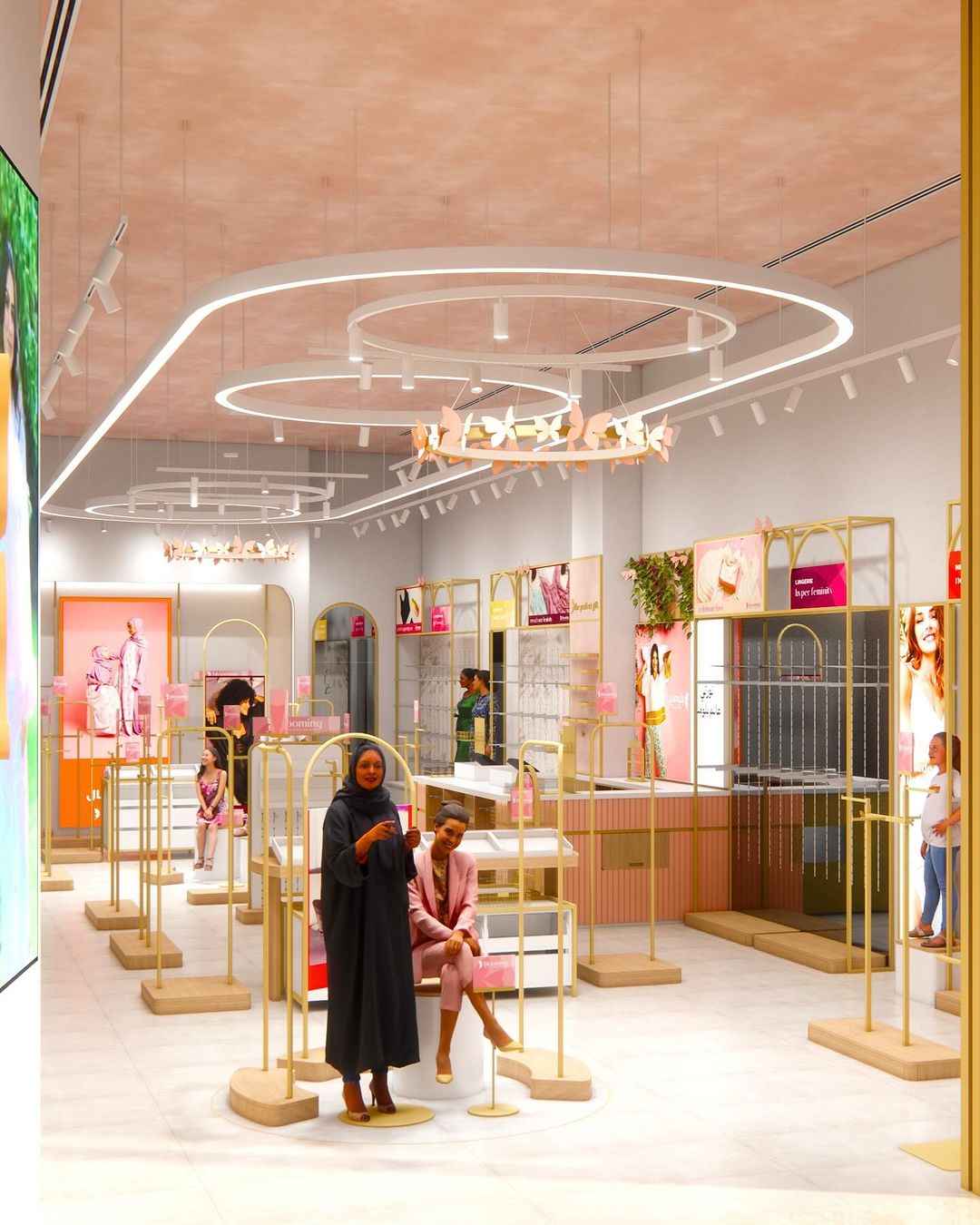
Effective product placement considers factors such as visibility, accessibility, and customer interest. By placing products in prominent locations, retailers can increase their visibility, stimulate impulse purchases, and drive sales.
Determining Aisle Width
Aisle width refers to the space between fixtures and displays within the store. It is essential to ensure adequate clearance for customers to navigate comfortably and safely throughout the store. Proper aisle width facilitates traffic flow, reduces congestion, and enhances accessibility to merchandise.
Adequate Checkout Counter Positioning
This involves selecting the location and layout of the checkout area within the store. Good checkout counters are based upon well-considered decisions about the number of checkout lanes, placement of POS terminals, and queuing systems to minimize wait times and expedite transactions.
By positioning checkout counters strategically, retailers can improve customer satisfaction and enhance overall store efficiency. This task can be made considerably easier by getting a retail fit-out contractor on board who can contribute his expertise in managing the customer flow within your retail space.
Why is retail space planning important?
Retail space planning is crucial because it sets the stage for your entire sales strategy. A well-planned space can subconsciously guide customers through the store, highlight key products, and create a positive atmosphere that intrigues and excites them, encouraging them to explore around and spend more of their time (as well as their money) on your business.
A well-designed retail space optimizes the shopping environment to enhance both ROI and brand image. Effective space planning can ensure that the layout and design of your retail space are strategically aligned with the objectives of your brand and customer preferences.
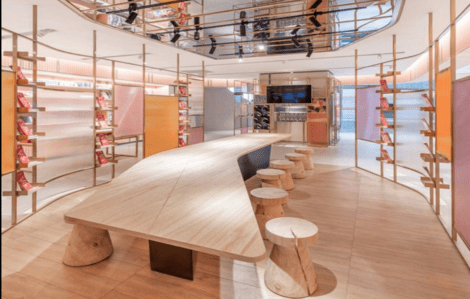
By carefully executing the components discussed in the retail store space planning section, retailers can create a welcoming and smooth shopping experience for their customers.
A well-planned retail space would not only maximize your sales opportunities by encouraging customer engagement and exploration but would also foster a positive perception of your brand.
Proper planning allows retailers to effectively leverage their physical environment to drive profitability and differentiate themselves in the competitive retail landscape.
What are the benefits of space planning in retail?
Space planning in retail offers several benefits that directly contribute to the success and profitability of a business. From reducing clutter and improving traffic flow to enhancing brand image and customer loyalty, space planning offers a range of perks that can give retailers a competitive edge in today’s dynamic and fast-paced market.
Here are some of the major benefits of space planning in retail:
Increased Sales
Proper space planning can optimize product placement, encouraging customers to browse several products at once, and gain more interest in your merchandise, eventually compelling them to spend more on your brand. This can be as simple as:
- developing a natural flow through the store that exposes customers to high-profit items
- analyzing data to determine which things sell best together
- putting products strategically to directly attract the attention of your customers towards your best-selling items.
Improved Customer Experience
A well-planned store layout guarantees that your merchandise is effectively and logically arranged and exhibited to your customers. This facilitates easier navigation and relaxed movement for your visitors. By streamlining the space planning, customers can easily find the items they need, which promotes a cohesive and efficient shopping experience.
Moreover, an organized layout encourages customers to explore and discover new products, making the overall buying experience more engaging and enjoyable.
Better Inventory Management
Effective space planning helps ensure that each product has the right amount of shelf space to avoid stockouts and overstocking. This results in more efficient inventory turnover, reduced carrying costs, and improved cash flow. Consequently, lower inventory costs contribute to higher profitability for the business overall.
Improved Staff Efficiency
A thoughtfully organized store layout streamlines various operational tasks for staff, enhancing overall efficiency. With clearly designated areas and well-defined product placement, employees can quickly locate items for customers, reducing search time and improving service speed.
By minimizing time spent on routine tasks like restocking and locating items, employees can devote more attention to delivering exceptional customer service.
Increased Flexibility
Space planning helps retailers adjust their store layouts and displays to match changing trends and seasons. With a smartly organized space, retailers can move products around, set up promotions, and highlight seasonal items as needed. This flexibility lets them take advantage of new trends and seasonal sales and manage their inventory better.
By staying responsive to changing consumer behaviors and market dynamics, retailers can optimize their offerings, enhance customer engagement, and maximize sales potential, ultimately ensuring sustained success in a dynamic retail landscape.
Which type of spaces are required in a retail store?
In a retail store, there are a variety of spaces that are crucial to the successful operation of the business. These spaces serve different functions, such as facilitating sales, providing storage for inventory, and serving as an office for administrative tasks. Without these spaces, it would be difficult for the store to meet the needs of customers and manage its operations effectively.
Here is a list of spaces that you’d commonly find in a retail space:
- Sales Floor: The sales floor is the primary area where customers browse through products, make purchases, and interact with store staff. It typically features displays, shelving units, product showcases, and signage to feature and advertise your products.
The sales floor should be well-designed to facilitate traffic flow, maximize product visibility, and create an engaging shopping experience. To effectively design your sales floor, look into retail fit-out services that can transform your space according to your vision, and give it a modern edge.
- Checkout Area: The checkout area is where customers complete their purchases and make payments. It includes checkout counters, POS terminals, bagging stations, and queue management systems. The checkout area should be strategically positioned near the exit to ensure customer comfort and efficient operation for staff.
- Fitting Rooms: Fitting rooms are dedicated spaces where customers can try on clothing and accessories before making a purchase. They should be equipped with mirrors, seating areas, and adequate lighting to provide a comfortable and private environment for customers to assess the fit and style of items.
- Storage Area: The storage area is used to store excess merchandise, supplies, and equipment not currently displayed on the sales floor. It may include backroom storage, stockrooms, or inventory closets. Proper organization and management of the storage area are essential to ensure efficient replenishment of merchandise and timely restocking of shelves.
- Office Space: Office space is used for administrative tasks, staff meetings, and managerial duties. It may include offices, workstations, conference rooms, and break areas for employees. Office space should be designed to promote productivity, collaboration, and communication among staff members.
- Customer Service Area: The customer service area is dedicated to addressing customer inquiries, providing assistance, and handling returns or exchanges. It may include customer service desks, information kiosks, or service counters staffed by knowledgeable personnel. The customer service area should be easily accessible and prominently located to ensure prompt assistance for customers.
- Display Areas: Display areas are used to showcase featured products, promotions, or seasonal collections. They may include display windows, end caps, promotional tables, or specialized showcases. Display areas should be strategically positioned throughout the store to attract customer attention and highlight key merchandise.
How do you maximize space in retail?
Retail stores can optimize their physical space by implementing smart design and planning strategies. To maximize the utilization of floor space, stores can position their displays, fixtures, and merchandise strategically to increase visibility and reduce clutter. This can be achieved by using modular shelf units, movable fixtures, and innovative storage solutions that make efficient use of both horizontal and vertical space.
Utilize vertical space with wall shelves, Slatwall panels, and grid systems that can hold hooks, baskets, or shelves for displaying a wide variety of items. Hanging displays from the ceiling can also be a space-saving option, particularly for showcasing seasonal items or promotional offers.
Similarly, to make use of your horizontal space, place long display tables or shelves along walls to showcase products in an organized manner, making it easy for customers to browse and compare items.
When planning your space, consider hiring a retail fit-out contractor to make the job more efficient. A retail fit-out company specializes in transforming empty spaces into vibrant retail environments that attract customers and drive sales and can significantly help you transform your aesthetic whilst ensuring maximum space within your store.
To further maximize space efficiency, consider an adaptable space design, emphasize product rotation, group together related items, and routinely reevaluate layout and display arrangements.
Creating a simplified and organized shopping experience can enhance customer satisfaction while utilizing every inch of available space. These strategies help businesses optimize their retail space and meet their business goals.
Conclusion
Effective space planning in retail is paramount for businesses looking to thrive in today’s competitive market. By meticulously organizing and designing retail spaces, businesses can create environments that not only attract customers but also drive sales and increase profitability. Space planning optimizes the store layout, enhances the customer experience, and reinforces the brand image, ultimately leading to a higher return on investment (ROI) and greater brand success.
If you are planning a renewal or commencement of your retail outlet, we recommend partnering up with a professional retail fit-out service provider. Exotic Commercial Interior Design Company has the right experience and team to significantly elevate the effectiveness of space planning efforts.
The professionals at Exotic Interior Studio bring unmatched expertise in transforming captivating and functional retail environments to life, one that aligns with your brand’s vision and objectives. From strategic layout designs to innovative display solutions, a commercial interior designer can unlock the full potential of retail spaces, maximizing ROI and ensuring long-term success.
Schedule a consultation today and let a professional team of retail interior experts bring your vision to life, maximize your ROI, and ensure long-term success.



